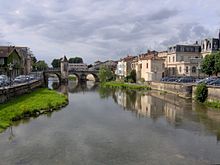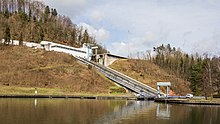Greater Region (Saar-Lor-Lux)
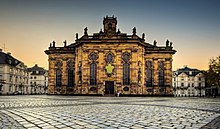
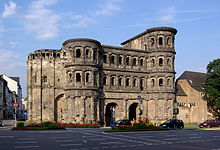

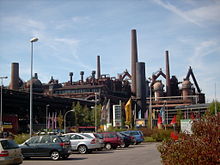


Bulk region refers to the bulk region Lux embourg, Lorraine (French Lor Raine), Saar land, Rheinland-Pfalz and Wallonia (→ SaarLorLux ). The cause of this shortened use of the term (linguistically a synecdoche ) lies in the difficulties of finding a common name for this greater region (see below). When queried by common search engines, “web reality” shows that the term “Greater Region” is used as a synonym for the European Greater Region described here in the majority of search results. The Greater Region wants to develop into a cross- border polycentric metropolitan region within a European framework .
The European Greater Region
The "Greater Region" is one of the major European regions and politically emerged from the core area Saar-Lor-Lux . It is an extension of the cultural cooperation between the regions of Saarland , Lorraine , Luxembourg , Trier and West Palatinate, which was contractually described in 1998 . It is not identical to the European region located in the same territory .
Surname
The European greater region of Luxembourg , Lorraine , Saarland , Rhineland-Palatinate , Wallonia , the German-speaking Community of Belgium and the French Community of Belgium have not yet found a specific name of their own. Various attempts to do this have so far remained unsuccessful. In the meantime, however, the term “the greater region” has established itself as a term. The monster word "the European greater region of Luxembourg, Lorraine, Saarland, Rhineland-Palatinate and Wallonia" is shortened to "the greater region". This assumes that the reader or listener knows the subregions, which is a characteristic of the increasing identification with the designated area. However, it is unclear to what extent this process is deliberate.
Another phenomenon in connection with the use of names allows conclusions to be drawn about the individual or collective feeling of belonging to the Greater Region: the name of a sub-region is associated with the addition “and the Greater Region” and thus describes the territory of the Greater Region from the perspective of the respective sub-region. An example of this was the European Capital of Culture Luxembourg in 2007 and the Greater Region - European Capital of Culture 2007 . In the present text, the Greater Region is always understood as the designation for the territory described below. A conceptual demarcation to sub-regions of the Greater Region, e.g. B. the Saar-Lor-Lux area should always be adhered to, as these areas are animated by different bodies, initiatives and networks and also correspond to different European funding areas. Mixing of terms such as the greater Saar-Lor-Lux region is not permitted, as important subregions (Wallonia, Rhineland-Palatinate) are excluded.
geography
The greater region with its more than eleven million inhabitants represents a non-uniform area in many respects. The economic problems with which the industrial and mining regions in upheaval are confronted in all four states have created a certain community of interests and led to the development of joint projects. such as the 'European Development Pole of the Sector Longwy (France), Rodange (Luxembourg), Athus (Belgium)' . But the location of the region and its size - more than 400 km from east to west and more than 350 km from north to south - make it a space of contact in which different ways of thinking flow together.
The region is part of the European ridge with northern Wallonia and the Rhine Valley . The numerous large cities located on this edge as well as the high density of inhabitants, transport networks and rivers there play a decisive role in structuring the region. The south side, on the other hand, connects them with a low-density diagonal that runs from the center of Spain to the eastern plains of the Paris Basin and has little dynamism. Between the two regions, the cross-border region Saar-Lor-Lux forms a focus with its industry and numerous urban agglomerations in the geometric center.
Within this asymmetrical scheme, the heavily populated axes of the great valleys ( Moselle , Saar ) and the extensive transport network that connects this central region via the highlands with the remote Rhine regions represent essential internal continuity elements and at the same time indispensable openings to the neighboring regions. ( Excerpt from a text by the author Evelyne Arnould, lecturer in geography at the University of Nancy 2 , from the population and social atlas of the Greater Region )
history
The history of the Greater Region and its sub-regions is a mirror of European history from the early days to current European history. Starting with evidence of the Celts (e.g. the ring wall of Otzenhausen and the princess grave European cultural park Bliesbruck-Reinheim ), there are outstanding evidence of all great European epochs in the area of the greater region. Due to the Latinization in the Roman Empire and the invasion of Teutons in late antiquity , the greater region has become a threshold region between the Germanic and Romanic language areas to this day . The cultural, but also historical, political, economic and social upheavals shape the greater region and its inhabitants to this day. This includes not only the countless wars, such as the War of the Four Lords , but above all the First World War with the Battle of Verdun and the Second World War with the Battle of the Bulge , the Maginot Line and the Siegfried Line , but also more peaceful forms of coexistence, e.g. B. the numerous cross-border commuters who do their work across borders. ( See also the official website of the Greater Region and the Interregional Labor Market Observatory )
A “ SaarLorLux Forum” was launched in October 2006 to take stock of the current situation and to further develop the greater region's culture and economy . The organizers were the European Academy Otzenhausen , the Center européen Robert Schuman and the Luxembourg Foundation Forum EUROPA . The forum is to take place once a year in the future, the objectives are to sound out future development potentials for cross-border cooperation and to stabilize and deepen supranational cooperation in the greater region.
Culture and art
The Greater Region was together with Luxembourg the European Capital of Culture 2007.
The culture of the Greater Region is shaped by its eventful history and shows masterpieces of European art. The works of art to be found in the cities of Trier , Mainz , Speyer , Völklingen , Metz , Nancy , Verdun , Bar-le-Duc , Luxemburg (city) , Liège and Namur alone demonstrate the importance of the culture of the Greater Region. There are 12 of the UNESCO as a World Heritage Site excellent facilities with a total of 30 individual monuments that enjoy this status. A general cultural and art history of the Greater Region that focuses on the artistic and cultural similarities has not yet been written. The cause lies in the national fragmentation in the 19th century, which hit this European cultural area in particular. Since the 19th century, the sub-regions of the Greater Region have been viewed from national standpoints as peripheral regions of the large nation-states and subordinated to them (often as part of national cultural propaganda ). This problem has been examined in the context of European integration especially since the 1990s and z. B. processed in thematic exhibitions.
The threshold function of the Greater Region as a European transition area for art movements and cultural influences represents a fundamental challenge for a reflected art and cultural historiography. The discussion of art in the Greater Region is characterized in almost all cases by an engagement with the mutual influences of the respective neighboring regions which, depending on the epoch, could also form a political or linguistic unit with the area under consideration. The interaction is expressed both in the merging of influences, e.g. B. can be seen on the baroque Ludwigsplatz in Saarbrücken , which absorbs and transforms the influences of the nearby Place Stanislas (today a world cultural heritage site ) in Nancy. But it also expresses itself as a strong negative reaction to the art of the neighbor, e.g. B. in the case of the antagonists of Art Nouveau in the French influenced Nancy and its École de Nancy and at the same time under German influence Metz with its Wilhelmine-influenced historicism .
In recent times, attempts have been made to try to present a common thematic representation of the artistic and cultural space of the Greater Region, but which in some cases could not survive the respective project funding phases (e.g. Grrrrr.eu, the Greater Region's culture portal for young audiences). Plurio.net has been in existence so far.
QuattroPole
Since February 29, 2000, the QuattroPole city network has been connecting the cities of Luxembourg, Metz, Saarbrücken and Trier with the aim of creating a virtual metropolis and positioning the city network in the greater region. Joint projects should ensure synergy effects and strengthen the economic attractiveness of the four cities on the European stage. Citizens have access to the services, knowledge and cultural offerings of the four twin cities. On March 12, 2007, the cooperation was confirmed by an agreement passed by the councils and procedural issues were clarified.
tourism
There are a number of interesting tourist destinations in the Greater Region. As a rule, they can be reached in day trips from any starting point within the greater region. The main tourist destinations are listed below:
- Saargemünd (France) with the world-famous Faïencerie (earthenware manufacture)
- Ship lift Saint-Louis / Arzviller near Saverne (France)
- Bitsch (France), a garrison town founded by Vauban with a monolithic citadel and one of the largest underground artillery works of the Maginot Line , Fort Simserhof , which can be visited
- Metz (France), capital of the Lorraine region with the high Gothic Cathédrale Saint-Etienne (including windows by Marc Chagall ) and the new branch of the Center Pompidou , the Center Pompidou-Metz
- Nancy (France), Art Nouveau town with Place Stanislas ( UNESCO World Heritage )
- Saarbrücken , state capital of Saarland with the baroque Ludwig Church and the grave church of Elisabeth of Lorraine (Countess of Nassau-Saarbrücken ) in the Sankt Arnual district
- Völklingen (Saarland), with the UNESCO World Heritage Site Völklinger Hütte
- Trier ( Rhineland-Palatinate ), old Roman city with numerous Roman cultural monuments (“ Porta Nigra ”) and an impressive museum landscape
- Mainz (state capital of Rhineland-Palatinate ), fort founded by the Romans as a Mogontiacum with the High Cathedral in Mainz and the Gutenberg Museum
- World Heritage cultural landscape of the Upper Middle Rhine Valley between Bingen and Koblenz (Rhineland-Palatinate)
- Luxembourg (capital of the Grand Duchy of Luxembourg), with medieval fortifications and Grand Ducal Castle
- Liège ( Belgium ) cultural center of the Walloon Region of Belgium with the Prince-Bishop's Palace and the high-baroque town hall
European Capital of Culture 2007
For the first time in the twenty-year history of the European Cities of Culture , an area comprising four countries and five regions with three languages has been designated the European Capital of Culture. The sub-regions have each chosen a key topic:
- Luxembourg: Migration
- Rhineland-Palatinate: Great European personalities
- Saarland: Industry as cultural heritage ( Route of Industrial Culture (Saar) )
- Lorraine: culture and memory
- Wallonia: expressions of modernity
Funding from the EU
The INTERREG IV-A program Greater Region of the European Union offers funding opportunities for a wide variety of projects with cross-border added value.
literature
- Literature on the Greater Region (Saar-Lor-Lux) in the Saarland Bibliography
- Eva Mendgen (Ed.): Au Center de l'Europe - In the Middle Kingdom² - des liens et des lieux - cultural community of the greater region . regiofactum-Edition / Verlag Hartung-Gorre, Saarbrücken-Konstanz 2013, ISBN 978-3-86628-393-0 .
- Eva Mendgen: The Greater Region is unfolding (La Grande Région s'affiche) . First official publication about the Greater Region Saarland Lorraine-Luxembourg-Rheinland-Pfalz-Wallonie (n) as a dynamic cultural region. Ed .: Association of the Greater Region Cultural Area (L'association espace culturel Grande Région). Saarbrücken, Luxembourg: regiofactum, 2009.
- "World Heritage Sites of the Greater Region" (Le Patrimoine Mondial de la Grande Région) . Ed .: Eva Mendgen for the Association for the Greater Region Cultural Area (L'association espace culturel de la Grande Région). Saarbrücken, Luxembourg: regiofactum, 2010. (The Greater Region is unfolding; No. 2)
- Saar-Lor-Lux. A euro region with a future? Ed .: Jo Leinen . St. Ingbert. Röhrig Universitätsverlag, 2001. 427 p. (History, Politics and Society series of the Saarland Democracy Foundation ; Vol. 6) ISBN 3-86110-242-0
- SaarLorLux from A – Z. Handbook for cross-border cooperation in the Greater Region. Ed .: Bernd Groß, Christian Wille, Claude Gengler, Patrick Thull. Baden-Baden: Nomos, 2006. 157 S. (Thinking Europe. Writings on European politics, economy and culture; 3) ISBN 3-8329-1944-9 .
- Martin Niedermeyer and Peter Moll: Saar-Lor-Lux - from the mining triangle to the “Greater Region”. Chances and possibilities of a cross-border regional policy in Europe . In: Fifty years of change in Saarland. Saarbrücken: Institute f. Regional studies, 2007. 359 pp.
- Anne Funk: Trial and Error - Identity for SaarLorLux . In: Saarbrücker Zeitung v. December 11, 2008, p. B4
- Wille, Christian: A nameless region. In: Forum for Politics, Society and Culture in Luxembourg. Luxembourg, No. 288 (focus: Greater Region), 2009, pp. 30–31. (PDF; 199 kB)
- Wille, Christian: Developments and structures of cross-border cooperation in the greater region. In: Digital and Interactive Atlas of the Greater Region. Interdisciplinary online project by the research unit IPSE at the University of Luxembourg. 2011
- Wille, Christian: Border Crossers and Border Spaces. Room constructions in the greater SaarLorLux region. (Luxemburg Studies / Etudes luxembourgeoises, Vol. 1), Frankfurt / M., Peter Lang, 2012 (393 pages) Book review (PDF; 146 kB)
- Wille, Christian: Cross-border labor market in the greater SaarLorLux region: Political visions and empirical realities . In: Lorig, Wolfgang H. / Regolot, Sascha / Henn, Stefan (eds.): The SaarLorLux region. Political claim, realities, perspectives. Wiesbaden, VS Verlag, 2016, pp. 115–143. more info
- Wille, Christian / Roos, Ursula: Cross-border living environments on the Luxembourg border? An empirical approach using the example of cross-border commuters and residential migrants . In: Pallagst, Karina / Hartz, Andrea / Caesar, Beate (eds.): Border Futures - Future Border - Avenir Frontière. Sustainability of cross-border cooperation. Working reports of the Academy for Spatial Research and Regional Planning 20, 2018, pp. 168–189. more info
Individual evidence
- ↑ Greater Region - Cross-Border Polycentric Metropolitan Region; Starting points and challenges.
- ↑ Download of the charter of October 9, 1998 ( memento of the original of September 20, 2011 in the Internet Archive ) Info: The archive link was inserted automatically and has not yet been checked. Please check the original and archive link according to the instructions and then remove this notice.
- ↑ Luxembourg and Greater Region European Capital of Culture 2007 ( Memento of the original from November 23, 2011 in the Internet Archive ) Info: The archive link was inserted automatically and has not yet been checked. Please check the original and archive link according to the instructions and then remove this notice.
- ↑ Description of the Greater Region on the official information page of the Greater Region ( Memento of the original from June 4, 2011 in the Internet Archive ) Info: The archive link was inserted automatically and has not yet been checked. Please check the original and archive link according to the instructions and then remove this notice.
- ↑ Description of the history of the Greater Region ( Memento of the original from September 18, 2011 in the Internet Archive ) Info: The archive link was inserted automatically and has not yet been checked. Please check the original and archive link according to the instructions and then remove this notice.
- ↑ Interregional Labor Market Observatory
- ^ Foundation Forum EUROPA ( Memento from February 18, 2013 in the web archive archive.today )
- ↑ UNESCO World Heritage Site in the Greater Region Website on the Plurio.net website, the official cultural portal of the Greater Region, accessed on July 21, 2011
- ↑ Archived copy ( memento of the original from July 20, 2011 in the Internet Archive ) Info: The archive link was automatically inserted and not yet checked. Please check the original and archive link according to the instructions and then remove this notice.
- ↑ Plurio.net - the official cultural portal of the Greater Region
- ↑ http://www.interreg-4agr.eu/
Web links to the greater region
General
- The website
- The flyer for the Greater Region (PDF; 5.8 MB)
politics
- Political side of the greater region
- EU funding program for the Greater Region
- Greater region statistics
Culture
- Greater region cultural area
- Plurio.net - the official cultural portal of the Greater Region
- Grrrrr.eu - the culture portal of the Greater Region for young people


